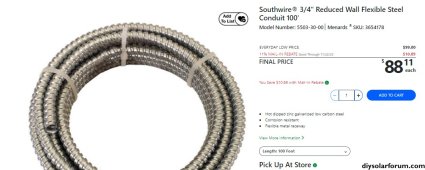I am running 8 AWG cable from my array on an exterior wall, down into a plastic disconnect on the exterior wall with waterproof fittings, then back up through a gland into an unfinished attic, and then as I drop into the finished space downstairs, it will be run in PVC conduit.
Does the entire run (attic, and exterior to/from the disconnect) need to be in conduit, or is it optional? PVC okay or should it be metal?
I also need to run my ground wire from, and to, the same locations. Should it be insulated, or uninsulated in the attic section, and can it be run together with the array cables through the attic?
Rob
Does the entire run (attic, and exterior to/from the disconnect) need to be in conduit, or is it optional? PVC okay or should it be metal?
I also need to run my ground wire from, and to, the same locations. Should it be insulated, or uninsulated in the attic section, and can it be run together with the array cables through the attic?
Rob



